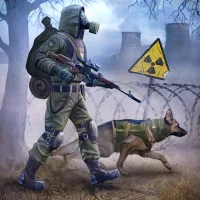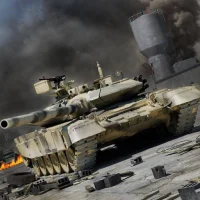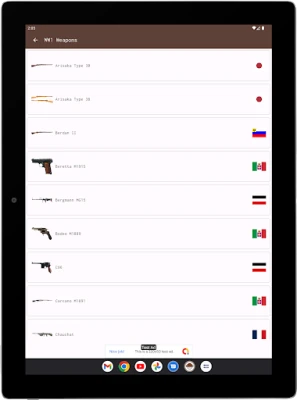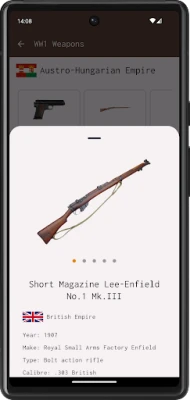
Latest Version
2023.4.0
April 06, 2025
Alan Camargo
Education
Android
0
Free
com.alancamargo.weapons.ww1
Report a Problem
More About WW1 Weapons
A Comprehensive Guide to World War I Weapons: A Resource for History Students and Firearms Enthusiasts
The First World War, spanning from 1914 to 1918, marked a significant turning point in military technology and warfare. This article delves into the diverse array of weapons used during this tumultuous period, providing detailed insights and visual references for both history students and firearms enthusiasts.
Introduction to World War I Weaponry
World War I introduced a new era of combat, characterized by the use of advanced weaponry that transformed traditional battle tactics. The conflict saw the emergence of machine guns, tanks, and chemical warfare, each playing a pivotal role in shaping the outcome of battles. Understanding these weapons is essential for anyone interested in military history or the evolution of firearms.
Infantry Weapons: The Backbone of the Battlefield
Infantry weapons were crucial during World War I, as soldiers relied on them for survival and effectiveness in combat. Here are some of the most notable infantry weapons from the era:
Rifles
The standard-issue rifle for many armies was the bolt-action rifle, known for its accuracy and range. The British Lee-Enfield, the German Mauser 98, and the French Lebel Model 1886 were among the most widely used. These rifles allowed soldiers to engage enemies at long distances, significantly impacting battlefield strategies.
Machine Guns
Machine guns revolutionized warfare by providing a high rate of fire and the ability to lay down suppressive fire. The Maxim gun, developed in the late 19th century, became infamous for its effectiveness in trench warfare. The British Vickers and the American Browning M1917 also played crucial roles, allowing troops to defend positions and inflict heavy casualties on advancing forces.
Artillery: The Heavy Hitters
Artillery was a dominant force in World War I, responsible for the majority of casualties. The following types of artillery were particularly significant:
Field Guns
Field guns, such as the French 75mm and the German 77mm, were designed for mobility and quick deployment. They could fire explosive shells over considerable distances, making them essential for both offensive and defensive operations.
Howitzers
Howitzers, like the British 18-pounder and the German 105mm, were capable of firing shells at high angles, allowing them to hit targets behind cover. Their versatility made them invaluable in trench warfare, where direct fire was often impossible.
Armored Vehicles: The Dawn of a New Era
The introduction of tanks during World War I marked a significant shift in ground warfare. These armored vehicles were designed to cross trenches and withstand small arms fire, providing infantry with much-needed support.
The Mark I Tank
The British Mark I was the world's first tank, debuting in 1916. Its unique rhomboid shape allowed it to traverse difficult terrain, while its armor provided protection against enemy fire. Although slow and mechanically unreliable, the Mark I paved the way for future tank designs.
French Renault FT
The Renault FT is often regarded as the first modern tank due to its revolutionary design, featuring a fully rotating turret and a layout that prioritized crew comfort and mobility. Its success influenced tank development in the years to come.
Aerial Warfare: The Rise of the Airplane
World War I also saw the advent of aerial combat, with airplanes being used for reconnaissance, bombing, and dogfighting. The following aircraft were notable during this period:
The Sopwith Camel
The Sopwith Camel was a British fighter aircraft known for its agility and effectiveness in dogfights. Pilots praised its performance, and it became one of the most successful fighters of the war.
The Fokker Dr.I
The German Fokker Dr.I, famously flown by the Red Baron, was another iconic fighter. Its distinctive triplane design provided exceptional maneuverability, making it a formidable opponent in the skies.
Chemical Warfare: A New and Terrifying Tactic
World War I also introduced chemical warfare, which added a horrifying dimension to combat. Poison gases, such as chlorine and mustard gas, were deployed to incapacitate and demoralize enemy troops.
Chlorine Gas
First used by the Germans in 1915, chlorine gas caused severe respiratory damage and panic among soldiers. Its effectiveness prompted widespread use, leading to the development of gas masks as a necessary defense.
Mustard Gas
Mustard gas, introduced later in the war, was particularly insidious due to its delayed effects and ability to linger in the environment. It caused severe skin blisters and respiratory issues, leading to long-term health problems for survivors.
Conclusion: The Legacy of World War I Weapons
The weapons of World War I not only shaped the course of the conflict but also laid the groundwork for future military innovations. Understanding these tools of war provides valuable insights into the strategies and experiences of those who fought during this pivotal time in history. For history students and firearms enthusiasts alike, exploring the evolution of these weapons offers a fascinating glimpse into the past and the relentless march of technological advancement in warfare.
As we reflect on the impact of World War I weaponry, it becomes clear that the lessons learned from this era continue to influence modern military practices and the development of new technologies. The study of these weapons remains essential for anyone seeking to understand the complexities of warfare and its profound effects on society.
Rate the App
User Reviews
Popular Apps







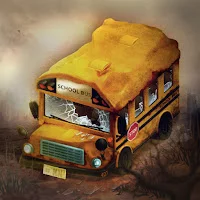
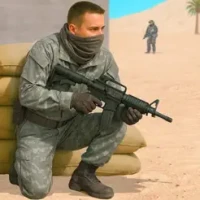

Editor's Choice



